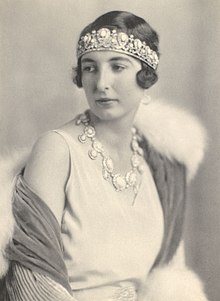Františka Orleánská (1902–1953)
| Františka Orleánská | |
|---|---|
| řecká a dánská princezna | |
 | |
| Úplné jméno | Františka Isabela Luisa Marie |
| Narození | 25. prosince 1902 Paříž, Francie |
| Úmrtí | 25. února 1953 (50 let) Paříž, Francie |
| Pohřbena | Tatoi |
| Sňatek | 11. února 1929 |
| Manžel | Kryštof Řecký a Dánský |
| Potomci | Michal Řecký a Dánský |
| Rod | Bourbon-Orléans |
| Otec | Jan Orleánský, vévoda z Guise |
| Matka | Isabela Orleánská |
| Některá data mohou pocházet z datové položky. | |
Františka Orleánská (Františka Isabela Luisa Marie; 25. prosince 1902, Paříž – 25. února 1953, Paříž) se narodila jako francouzská princezna z linie Bourbon-Orléans a sňatkem se stala princeznou řeckou a dánskou.
Život
Františka Orleánská se narodila v Paříži jako druhá dcera Jana Orleánského, vévody z Guise (orleanistického pretendenta francouzského trůnu pod jménem Jan III.) a jeho manželky, francouzské princezny Isabely Orleánské. Františčin bratr, hrabě Jindřich Pařížský, se stal po otci pretendentem francouzského trůnu jako Jindřich VI.
11. února 1929 se v Palermu provdala za prince Kryštofa Řeckého a Dánského (1888–1940), jehož se stala druhou manželkou. Kryštof se narodil jako nejmladší syn řeckého krále Jiřího I. a jeho manželky Olgy Konstantinovny Romanovové. Byl tedy vnukem krále Kristiána IX. Dánského, kterému se přezdívalo "tchán Evropy".
Tento sňatek byl v té době neobvyklý, jelikož šlo o spojení katoličky a nekatolíka. Manželé spolu měli jednoho syna, spisovatele a prince Michala Řeckého a Dánského, který se oženil s řeckou umělkyní Marinou Karellou. Protože se Michal neoženil podle svého postavení a práv řecké královské rodiny, byl zbaven veškerých práv na řecký trůn.
Tituly a oslovení
- 25. prosince 1902 – 11. února 1929: Její královská Výsost princezna Františka Francouzská
- 11. února 1929 – 25. února 1953: Její královská Výsost princezna řecká a dánská
Vývod z předků
Reference
V tomto článku byl použit překlad textu z článku Princess Françoise of Orléans (1902–1953) na anglické Wikipedii.
Externí odkazy
 Obrázky, zvuky či videa k tématu Františka Orleánská na Wikimedia Commons
Obrázky, zvuky či videa k tématu Františka Orleánská na Wikimedia Commons
Média použitá na této stránce
Coat of arms of the Kingdom of Greece in 1936–1973
- Royal Coat of Arms of Greece under the Glücksburg dynasty, created after the restoration of King George II to the throne in 1935, to the exile of King Constantine II in 1967 and finally until the abolition of the monarchy in 1973.
- The Escutcheon features the white cross on a dark blue field of Greece. The Inescutcheon features the Arms of the Greek line of the House of Schleswig-Holstein-Sonderburg-Glücksburg. The shield is then topped with a golden Royal Crown.
- It features an escutcheon divided by the red and white cross of the Order of the Danneborg, the first quarter features the arms of Denmark (three crowned blue lions and nine hearts in yellow field). The second of Schleswig (two blue lions passant in yellow field). The third divided into four; the chief features the three royal crowns in blue field of the Kalmar Union, the second half with a crowned stockfish on red field of Iceland and the last half divided between the ram of the Faroe Islands and a polar bear of Greenland, both on blue fields. The fourth quarter is divided between two halves, the chief depicts a yellow field with a blue lion passant over nine red hearts of the King of the Goths, the lower half depicts a crowned golden lindorm on a red field of the King of the Wends.
- Upon it is another inescutcheon in red, divided into four quarters: the first a a silver nettle leaf of Holstein, the second the a swan with a golden crown of Stormarn, the third a knight dressed in golden armor on a silver horse of Dithmarschen and the fourth of a golden horse's head of Lauenburg.
- Upon it is another inescutcheon divided the first features the red and yellow bars of Oldenburg, the second a golden cross on a blue field of Delmenhorst.
- The escutcheon rests on a golden pedestal and supported by two human figures representing the Greek mythological hero Herakles (Heracles), holding a wooden club and wearing the skin of the Nemean lion.
- The escutcheon is surrounded by the ribbon and cross of the Order of the Redeemer, the cross depicts Christ Pantocrator, surrounded by the order's motto:"Η ΔΕΞΙΑ ΣΟΥ ΧΕΙΡ, ΚΥΡΙΕ, ΔΕΔΟΞΑΣΤΑΙ ΕΝ ΙΣΧΥΙ" or "Thy right hand, O Lord, is become glorious in power" from Exodus, 15:6.
- The motto of the Coat of arms and of the dynasty, depicted on a golden ribbon below the pedestal reads: "Ἰσχύς μου ἡ ἀγάπη τοῦ λαοῦ" or "The people's love, my strength"
- The coat of arms is then surrounded by a dark blue mantle and topped with another royal crown.
Autor: Sodacan, Licence: CC BY-SA 3.0
Royal arms of Denmark from 1972.


